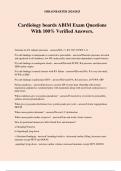©BRAINBARTER 2024/2025
Cardiology boards ABIM Exam Questions
With 100% Verified Answers.
Normals for PA catheter pressures - answer✔RA <7, RV 30/7, PCWP 3-11
PA cath findings in tamponade or constrictive pericarditis - answer✔Diastolic pressures elevated
and equalized in all chambers, low BP, tachycardia, interventricular dependence (septal bounce)
PA cath findings in cardiogenic shock - answer✔Elevated PCWP, RA pressure, and decreased
SBP/cardiac output
PA cath findings in mitral stenosis with RV failure - answer✔Elevated RA, PA (very elevated),
PCWP, nl SBP
PA cath findings in pulmonary HTN - answer✔Elevated PA, RA pressures, nl PCWP, SBP
Pulsus paradoxus - answer✔decrease in systolic BP of more than 10mmHg with normal
inspiration; palpated as weakened pulse with inspiration along with more heart contractions to
pulse beats
What conditions give you pulsus paradoxus? - answer✔Constrictive or restrictive pericarditis,
asthma, tension pneumothorax
What gives you pulsus bisferiens (two systolic peaks per cycle) - answer✔Aortic regurgitation,
HOCM
What causes pulsus alternans? - answer✔Severe LV dysfunction
What causes pulsus tardus et parvus? - answer✔Late and weak; Aortic stenosis
How do positional maneuvers affect blood flow and murmurs?
a) Standing/Valsalva
b) Squatting/Lying down
c) Sustained handgrip - answer✔-standing/valsalva - decreased cardiac filling, decreases most
murmurs except MVP and HOCM
-squatting/ lying down - increase cardiac volume, increased murmurs except MVP, HOCM
, ©BRAINBARTER 2024/2025
-sustained handgrip - increases systemic resistance, decreases murmur in HOCM, AS
What are the stages of the Valsalva maneuver? - answer✔-Phase one is the onset of straining
with increased intrathoracic pressure. The heart rate does not change but blood pressure rises.
-Phase two is marked by the decreased venous return and consequent reduction of stroke volume
and pulse pressure as straining continues. The heart rate increases and blood pressure drops.
-Phase three is the release of straining with decreased intrathoracic pressure and normalization of
pulmonary blood flow.
-Phase four marks the blood pressure overshoot (in the normal heart) with return of the heart rate
to baseline.
What causes a physiologic split S2? - answer✔Increased blood volume in the RV prolongs
systole and delays pulmonary valve closure
What causes a fixed split S2? - answer✔Pulmonary stenosis, PE, LV pacer, RBBB, MR (early
AV closure), ASD, RV failue
What causes a paradoxic split S2 - answer✔LBBB, RV pacing, HOCM
What causes an S3? - answer✔Rapid LV filling - acute ventricular decompensation, severe AR
or MR
What causes a S4? - answer✔Decreased ventricular compliance during atrial contraction -
ischemic heart dz, AS, MR, HOCM, hypertrophic or diabetic cardiomyopathy, HTN heart dz,
concentric LVH
Can you have a S4 with atrial fibrillation? - answer✔No - no atrial contraction
What are the parts of the venous waveform? - answer✔A wave - atrial contraction
X descent - atria relax, RV fills rapidly; Bottom/middle of x descent is TC valve closure (c wave)
V wave - ventricle contacting against closed TC valve
Y descent - TC valve opens, passive emptying into ventricle
What gives elevated a and v waves - answer✔Pulmonary HTN, RV infarction
What leads to Large r side v waves - answer✔Septal rupture
What diseases lead to Large v waves - answer✔TR (right), MR (left)
Rapid x and y descent - answer✔Constrictive pericarditis, restrictive cardiomyopathy,
tamponade (x descent only, loss of y descent)
, ©BRAINBARTER 2024/2025
Large a waves - answer✔TS, severe RVH (on right), MS
Cannon a waves - answer✔AV disassociation - complete heart block, ventricular pacing
Slow Y descent - answer✔Delayed atrial emptying - TS
Most important prognostic factor with CAD - answer✔Degree of LV dysfunction
Causes of resting ST elevation - answer✔MI, pericarditis, LV aneurysm, LBBB, ventricular
pacing, LVH, early repolarization
Giving nitrates causes severe decompensation in a IWMI pt. What happened? - answer✔Pt had R
side infarction as well, the preload reduction from the nitrate now meant little flow getting to the
L side of the heart
MR due to papillary muscle rupture is most common with MI in this region - answer✔Inferior;
posteromedial papillary muscle has only single vessel supply (RCA) while the anterolateral has
two vessels
VSD is more likely with MIs here - answer✔Anterior, inferior
Contraindications for B-blockers - answer✔Bradycardia, hypotension, 2nd or 3rd degree AVB,
pulmonary edema, asthma. NOT DM
When to use non-dihydropyridne CCBs in ACS - answer✔Contraindications to B blockers,
continued ischemia, but NO LV dysfunction
What anticoagulant to use with ACS - answer✔Enoxaparin good, but have to stop 12-24 hrs
before CABG
Fondaparinux is increased risk of bleeding, do not use if going to do PCI - increased risk of
catheter thrombosis and coronary complications
If using Fondaparinux and decide to do PCI, change to heparin or bivalirudin
What are the platelet P2Y12 receptor blockers - answer✔Clopidogrel, ticlodipine, prasugrel,
ticagrelor
Prasugrel or ticagrelor vs clopidogrel - answer✔Faster onset, more anti platelet activity, more
risk of bleeding
GP IIb/IIIa inhibitors, action and use - answer✔Abciximab, eptifibatide, tirofiban, limifiban
Block platelet aggregation
Use in any ACS pt going to cath for probable PCI




